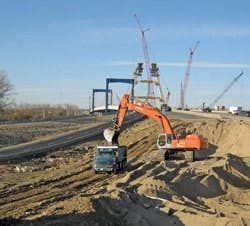2010 Top 10 Roads - No. 1
There was no fighting for air.
When it came to right-of-way acquisitions and design challenges on the I-29/35 kcICON Project, the claim for vertical space went uncontested, which certainly helped as crews wrestled with available land. Pinched in an urban/industrial environment, Missouri DOT officials had to figure out a way to modernize a 1950s floor plan, which was scuffed with short, steep ramps and short merge areas, while still abiding by a fiscally strict $245 million budget.
Using a series of retaining walls (a total of 76,000 sq ft), MoDOT and prime contractor Paseo Corridor Contractors (PCC), a joint venture between Clarkson Construction Co., Massman Construction Co. and Kiewit Construction Co., built its way up and out of a potential problem. The result has been the execution of one of the most successful road construction projects in the history of the state, as well as a No. 1 ranking on Roads & Bridges’ 2010 Top 10 Roads list.
“Constructing a lot of MSE walls allowed us to provide a bigger surface up on top,” Brian Kidwell, project engineer for MoDOT, told Roads & Bridges. “The interchanges are rebuilt, so as part of that we have gentler curves and longer acceleration lanes. The worst part [of the old design] was those forced exits where if you are going down the left lane of a two-lane interstate it would force you off into an exit. You had all of these cars jockeying back and forth to either get to an exit or avoid having to take off on an exit they weren’t trying for.”
Taking the project vertical stunted the growth of right-of-way acquisitions. Officials had originally marked $25 million toward the purchase of additional land, but only about $6 million was actually used.
“We tried to stay away from all of the high-impact takings and really forced the design-builders into snaking their way through this corridor in an attempt to stay off the big industrial and residential impacts,” Kidwell said.
The move was a brilliant offspring of MoDOT’s fixed-cost, best-value, design-build process, a first-of-its-kind approach that involves taking the interests and needs of the impacted community and placing them in the hands of the design-build team, which can then shape them into the best transportation solution. The road builders ended up reaching into their travel bags for answers. According to Kidwell, past experiences from projects in other states have been applied to the I-29/35 kcICON Project. In turn, PCC has submitted over 40 equal or better-change proposals that have been approved by MoDOT. Kidwell also estimated that almost 600 design changes have occurred since project inception in April 2008.
“I don’t know another DOT that had just a blank slate when they started procurement,” he said. “We wanted to compile all of the best options that folks had experienced, and a lot of these guys work all over the country. We were just trying to capture all of that on our project.”
Different looks started kicking in early in the life of the project, and perhaps the most significant one dealt with material prices a couple of years ago. With the price of steel threatening to make a financial mess of the project, the design-build team decided to turn the land bridges from steel over to concrete. Crews were forced to stick with steel for the widening of a couple of railroad bridges, but instead of using H piles, concrete piles were used.
All of the five raised interchanges—half-diamond, partial diamond/partial clover leaf, single-point urban interchange, collector distributor and one that is being described as just an exit-entrance ramp—remain active, and the schedule remains well ahead of the July 1, 2011, completion date. When all is said and done, the 4.7-mile section will be widened from two lanes in each direction to three lanes, which should be able to carry the 102,000 vehicles a day without any pain for some time to come. The project also involves the construction of eight new bridges and the widening of five more. One of the new spans is the Christopher S. Bond Bridge, which has been named to the 2010 Top 10 Bridges list, which will be featured in the November issue of Roads & Bridges.
Going down a different road was not an option when it came to maintaining traffic—two lanes in each direction—through the work zone. MoDOT divided the project into several phases to keep within the tight constraints of the playing field.
“We just keep scooching them left, scooching them right and keep moving them around,” Kidwell said.
